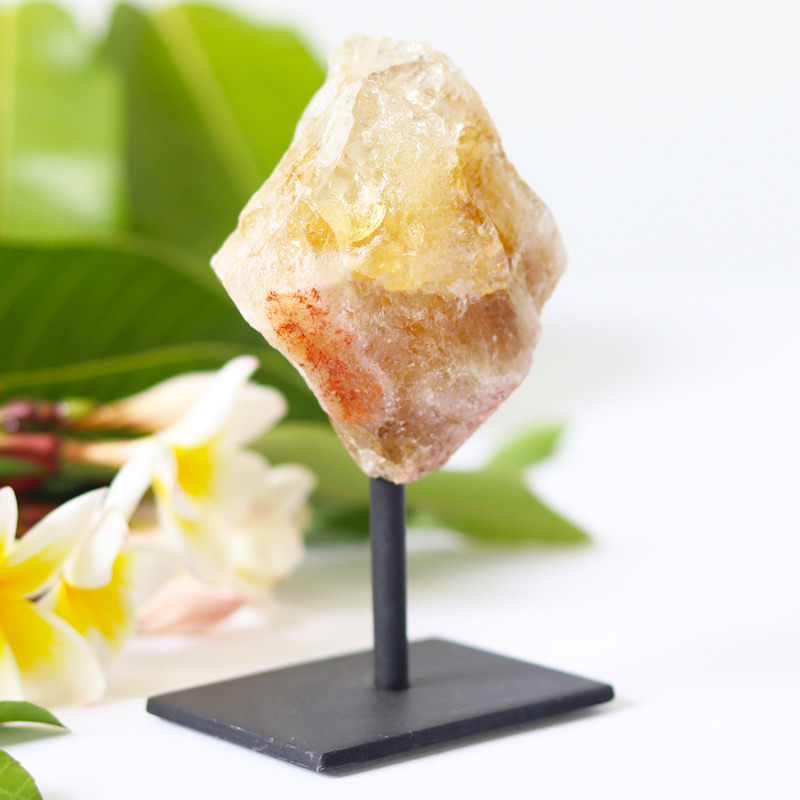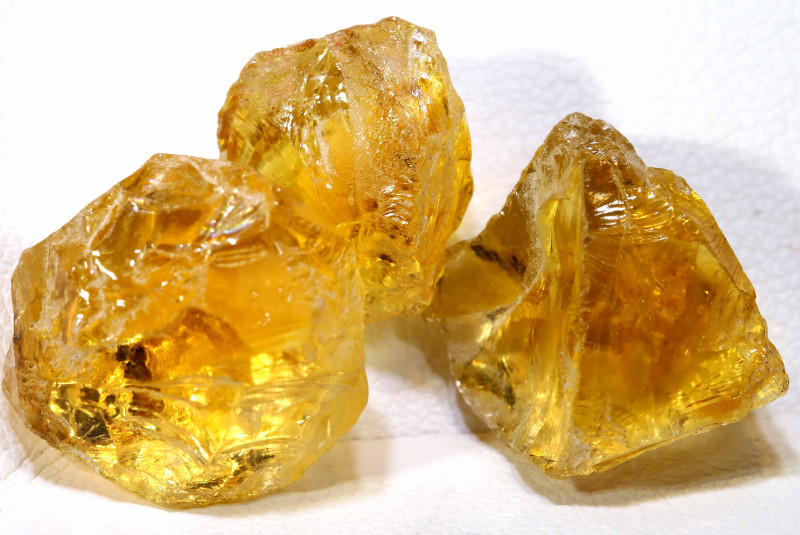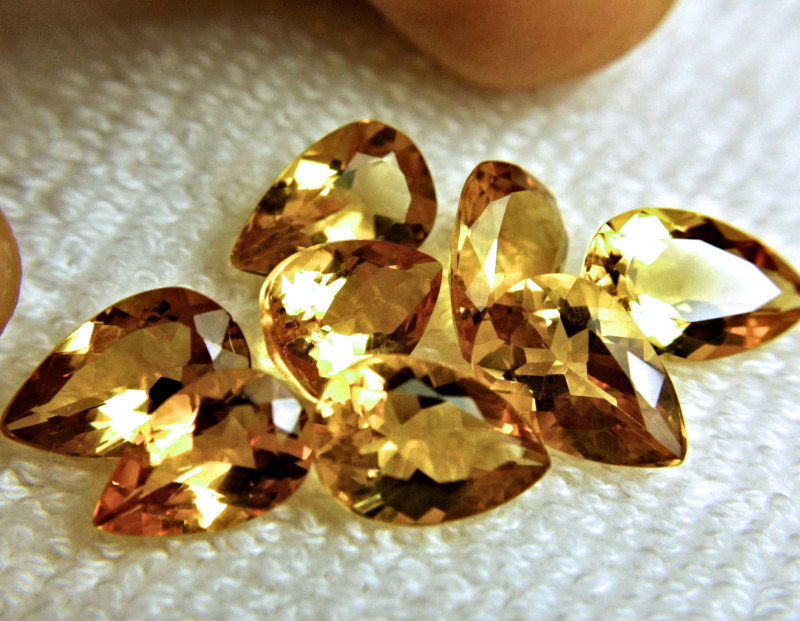
Citrine Gemstone: Meaning, History, Properties, and Value
 If you’ve ever wanted to capture the power of sunshine in a gemstone, look no further than the citrine stone! One look at citrine’s yellow brilliance fills the soul with warmth and vitality. So what is citrine and what makes it so powerful?
If you’ve ever wanted to capture the power of sunshine in a gemstone, look no further than the citrine stone! One look at citrine’s yellow brilliance fills the soul with warmth and vitality. So what is citrine and what makes it so powerful?
Citrine is a gorgeous quartz mineral in yellow or orange tones that overflows with positivity. Thanks to its versatility, citrine is perfect for pairing with gold or silver jewelry. Outfit staple, anyone?
Beyond its stunning visuals, the citrine stone can bring the luck and confidence needed to achieve your goals.
Citrine’s history is a fascinating tale that highlights its many benefits and uses today. Our comprehensive guide will tell you everything you need to know about this brilliant gem.
Keep reading to learn about all the citrine information that makes this a must-have gemstone!

About Citrine
Citrine is a variety of silica mineral quartz that comes in a range of yellow hues. As the second most common mineral in the Earth’s crust, quartz varieties are everywhere. Other quartz stones include amethyst, bloodstone, and aventurine, to name a few.
If you were born in November, say hello to your birthstone citrine! The warm yellows and oranges of this stone perfectly match this time of year. As the turning point between autumn and winter, November balances both seasons.
Did someone say balance? The citrine zodiac stone graces Libra, the sign of balance and harmony. Given their reputation for optimistic idealism, it only makes sense that Libras be represented by this crystal of joy and love.
Speaking of love, citrine is the traditional gift to commemorate 13th wedding anniversaries. If you know someone approaching this milestone, this is the perfect gift to celebrate their success and happiness.
As we’ve mentioned, citrine is a quartz mineral. That means citrine’s chemical composition is silicon dioxide or silica. In fact, over 95 percent of all known rocks on Earth are mostly made up of silica. While mostly used in the construction industry, you can find it in food, ceramics, and of course jewelry!
With its various uses, silica is clearly pretty tough. Because of this, citrine comes in at an impressive 7 on the Mohs hardness scale.
Ready to know more? Let’s take a look at the citrine stone’s specific characteristics.
Citrine Specifications and Characteristics
Color: yellow, orange, golden, brownish orange, reddish-orange
Crystal structure: trigonal
Luster: vitreous (glass-like)
Transparency: transparent to translucent
Refractive index: 1.54-1.55
Density: 2.6-2.7
Cleavage: none
 Citrine Stone Meaning and Uses
Citrine Stone Meaning and Uses
What does citrine do spiritually? And what does the citrine stone symbolize?
Citrine symbolizes joy, optimism, and success. We mentioned that Chinese legends refer to it as the “Success Stone,” and for good reason! It can help you manifest achievement and wealth in abundance. This reputation has led to another nickname for citrine: the “Merchant’s Gemstone.”
Beyond money matters, citrine can rid you of sadness and self-doubt as well. Wearing citrine jewelry can repel bad vibes and bring out your joy and creativity wherever you go.
Do you catch yourself worrying about what others think of you? Citrine can take those fears and replace them with confidence, letting you access your full personal power.
Speaking of power, citrine is connected to Sekhmet, the Egyptian goddess of war. Not only was she the protector of pharaohs, but she offered healing and cures to her followers as well.
Luckily, you don’t have to be an Egyptian goddess to tap into citrine’s healing powers!
In fact, let’s look at the many healing citrine properties.

Citrine Spiritual and Healing Properties
The vibrations and frequencies of crystals make them powerful conduits for crystal healing. So, when it comes to healing, what is citrine good for?
Physically, citrine’s healing benefits can relieve issues with digestion and sleep. It can strengthen the digestive tract, getting rid of toxins in your system.
Do you deal with nightmares? Citrine can eliminate these, along with increasing energy in anyone who deals with chronic fatigue.
In terms of emotional healing, the citrine stone benefits anyone trying to overcome fear or grief. Its detoxifying properties eliminate negative energy and open your mind to more positive perspectives and ideas.
Chakra healing involves connecting with our spiritual selves through energy centers, chakras, in our bodies. The citrine stone corresponds to two chakras: the Solar Plexus Chakra and Sacral Chakra.

Solar Plexus Chakra
The solar plexus chakra is located in the center of your body just below the ribs. Associated with fire, it’s the center of passions, power, and strength.
When the solar plexus is blocked, you might feel low self-esteem and confusion. Citrine can open this chakra, making you happier and increasing self-respect.
Sacral Chakra
The sacral chakra sits above the pubic bone, anchored at the spine. This chakra is the center of all things fun and bright: creativity, friendliness, and sexuality.
A blockage in the sacral chakra leads to unbalanced emotions and impulses. With citrine, however, this chakra opens for emotions to flow freely, encouraging you to reach out to others.
Citrine Gemstone Properties
Are you interested in buying citrine jewelry but don’t know where to start? In this next section, we’ll be covering some important factors to keep an eye out for when gemstone shopping. Let’s first start with citrine color.
Color
Want to paint with all the colors of the wind like Pocahontas? The citrine stone has got you covered. Its hues range from the pale yellow of a lemon rind to the rich, earthy browns of a cherry tree. With a host of golden yellow and orange shades between these, you’re sure to find the perfect one for you.
In its natural state, citrine is usually a light yellow with smoky shadows throughout. While you’re more likely to find stones in this shade, the darker-colored varieties are highly sought after.
The most coveted of these is the Madeira Citrine, named for its resemblance to the Portuguese wine and its amber glow. Another notable variety is the Fire Citrine. Glimmering in deep red-orange tones, this stone is only mined from the Linha Estefania Mine in Brazil and heat-treated to achieve its vivid color.
If you’re wondering how citrine gets its color, it’s iron!
As natural citrine has gotten harder to find, more jewelers have turned to heat treatments of other gems to achieve the trademark citrine colors. Let’s check them out!

Treatments
While the most common shade of citrine is the pale yellow of its natural state, natural citrine itself is rare. In fact, most citrines available today have undergone heat treatment. These procedures are completely safe, industry-approved, and elevate citrine colors and clarity.
Often, citrine’s sister stone amethyst gets this heat treatment to be sold as citrine. This variety of amethyst goes by “burnt amethyst” sometimes. When heated, it goes from a dull violet shade to vibrant yellow or orange, depending on how dark it was to begin with.
Another stone that transforms into citrine with heat treatment is smoky quartz. Unlike amethyst, heat-treated smoky quartz displays lighter shades of yellow.
Heat treatment won’t change the quality of your stone, but if you fancy yourself a citrine purist, here’s how to tell it apart. If the colors show up most vividly at the tips of the stone while the base looks white, it’s probably been heat-treated.
Now that we’ve covered citrine treatment, let’s delve into its clarity.
Clarity
Beyond giving a gemstone its signature look, color plays a crucial role in determining a crystal’s clarity.
Because gemstone colors vary, however, gemologists don’t typically grade it on colored stones the way they do diamonds. Instead, the Gemological Institute of America (GIA) developed three classifications of clarity based on the typical amount of inclusions.
The citrine stone falls under Type I clarity. In other words, the few inclusions it has aren’t visible. For the savvy shopper out there, keep in mind that eye-visible inclusions lower citrine’s value.
Not all inclusions decrease a stone’s beauty, however. Natural citrine can display a type of inclusion called color zoning, where the distribution of color is not uniform. For citrine, this usually comes in two forms:
Tiger Stripes: These inclusions occur when one or more fractures in the crystal heals over, leaving one or more lines that resemble a tiger’s signature markings.
Zebra Stripes. Almost identical to tiger stripes, these only differ in their pattern. Both of these typically occur when a stone “twins” during its formation. Twinning is when two crystals grow together, layered over each other.
Next up on our list is cut. Let’s dive in!
Cut
Because citrine is durable, it comes in a variety of cuts. The most popular shapes are the standard round and oval cuts. These capture citrine’s trademark colors in all their brilliance.
While lower-quality citrines often become cabochon stones, some designers have experimented with unconventional shapes and intricate designs or carvings. Because of their craftsmanship and customization, these pieces are much more valuable.
Now that you know all the citrine specifications, let’s take a journey through its history.

Citrine Legends And History
You’ve probably guessed by now that the name citrine is somehow related to citrus, right? Well, you’re right! Citrine actually went by yellow quartz until 1546, when renowned mineralogist Georg Bauer named it citrine. This word originates from the French word citron, or “lemon.”
Citrine’s place in history stretches even further back, all the way to ancient times.
In Europe, this crystal had a notable reputation from Scotland down to Greece and Rome. Ancient Greeks made custom decorations by carving designs into them and hanging them as ornaments. The ancient Romans had a similar idea and used citrine to create intaglios. These were small engraved gems that often featured images or inscriptions.
Up in Scotland, soldiers used citrine embellishments on their swords and daggers, wielding them into battle. Apparently, some even fastened their entire sword handles from the stone. Nothing says prestige like a citrine sword!
Over in China, the beliefs around the citrine stone were equally fascinating. According to Chinese legends, citrine had the power to manifest success. Therefore, only those with the generosity to share their success should receive it.
Even Chinese emperors embraced the magical properties of citrine. They believed it could make them wiser and broaden their minds, so they often wore citrine jewelry. It couldn’t have looked too shabby either, right?
Historians have uncovered artifacts from the Victorian era that show citrine was quite the favorite in this time, too. A gold pendant with a citrine center stone and ornate citrine brooches were discovered and are believed to be from the mid-1800s.
Citrine in the Modern World
Stepping into the 20th century, citrine’s popularity skyrocketed during the Art Deco era of the ‘20s and ‘30s. As people searched for an escape after World War I, many turned to the cinema. Movie stars in this era sported citrine statement pieces that definitely turned heads.
Greta Garbo, the acclaimed star of 1936’s Camille, boasted an Art Deco jewelry collection that featured citrine. In fact, citrine sales went up exponentially after Garbo was spotted flaunting a large citrine ring.
Now let’s shift from how the citrine reputation formed to how this gemstone actually forms!

Citrine Origins & Sources
Citrine stones grow in fascinating ways. Most citrine forms inside geodes, hollow rocks where bubbles get trapped and create cavities inside. Here, the silica liquids mix with liquid iron before crystallizing into this beautiful gem.
Where can you find citrine? Well, a few places. Citrine shows up in both igneous and metamorphic rocks. In igneous rocks, magma travels through volcanic pipes and gradually cools. With intense heat and pressure, these can shift into metamorphic rocks, like granite, where citrine forms, too.
You don’t need to dig around volcanoes to come across citrine, though. Clastic sediments – pieces of pre-existing rocks that break off and get carried to new locations – contain citrine in some locations.
Citrine Mining Locations
Most citrine deposits are based in Brazil and Uruguay. The Rio Grande do Sul in southern Brazil generates over 650 pounds of citrine a month!
Natural citrine comes from the Ural Mountains in Russia and the island of Madagascar as well.
As of late, Bolivia has started producing large amounts of citrine. Their signature citrine export is a combination of amethyst and citrine called ametrine, with yellow and purple coloring.
Other countries with citrine deposits include France, Belize, Namibia, India, and China.
As you can see, citrine has many impressive qualities. So, what are citrine stones worth?
Pricing and Value
Citrine stone prices can vary based on carats, cut, and most importantly, color. Let’s break these down.
Generally, citrines will run between $4-30 per carat. Lighter colors tend to be more affordable than the deeper-colored stones. It’s no surprise that more carats mean higher value. Citrine stones with 10 carats or more range from $4-40 per carat.
When it comes to citrine color, pricing can get a little tricky. Generally, stones with deeper tones, like Princeton orange or pumpkin, are usually rarer. Any citrine crystal with a rich, saturated coloring without visible inclusions is valued higher by jewelry dealers.
Any natural gemstone is almost always more valuable than a treated one. Citrine is a natural light yellow color, however. Because the deeper orange-hued stones have a higher market value, treated citrine stones in these shades could go for more than natural citrine.
As mentioned, citrine can be fashioned into delicate carvings and custom cuts, which are highly valued.
In general, however, citrine is pretty affordable. You can find stunning citrine jewelry or crystals at reasonable prices.
Overall, there’s a citrine gemstone out there for every taste and every buyer.
Now that we’ve covered citrine prices, let’s look into how we can take care of these beautiful jewels.

Care And Maintenance
Citrine is a strong stone that’s great for everyday wear, but it’s not indestructible. As a 7 on the Mohs scale, citrine is still vulnerable to scratches from gemstones higher on the scale, like topaz, sapphire, and diamond.
It’s important to clean and take good care of your crystals. Here’s how:
Be aware that sudden changes in temperature can cause fractures in the crystal, so try to keep it in a consistent environment.
Some citrine gems can change color if they’re in intense light, too, so we recommend keeping them in an opaque, closable container when not in use.
When it comes to cleaning your gemstones, follow these steps:
Get a bowl, fragrance-free soap, warm water, and a soft brush such as a toothbrush.
Fill the bowl with your warm water and soap. Mix them thoroughly.
Place your citrine in the solution and let it soak for about half an hour.
If there’s still dirt or debris, use the soft brush to gently scrub it off.
Rinse all the soap residue off and dry with a microfiber cloth.
And you’re good to go! If you practice this routine about once a month, your citrine will sparkle for a lifetime.
![10x8 mm Oval 2 pcs 4.46cts Golden Yellow Citrine [VVS]](https://df2sm3urulav.cloudfront.net/tenants/gr/uploads/images/1435000-1439999/1435107/604dc3ba7aee0.jpg)
Need a Burst of Light in Your Life? Buy Citrine Stones
Congratulations! You now have all the information you need to know about citrine stones. These yellow crystals pack warmth and happiness that will enrich your life. Their joyful spiritual properties reflect outward in their vibrant, golden shine.
Citrine has journeyed from the swords of Scottish soldiers to the Art Deco collections of movie stars. While citrine meaning and uses vary around the world, all who encounter citrine stones will instantly feel their radiant energy.
Interested in using citrine for chakra healing, meditation, or to wear as a dazzling piece of jewelry? Either way, you can be sure that your citrine stone will captivate all.
Searching for the perfect yellow crystal? Shop for citrine stones today!
Search the Gemstone Encyclopedia
Related Auctions
Related Articles
Azotic treatment of Topaz and Quartz is a treatment that creates a layer of color over a gemstone. Learn more about this treatment and check out our stones fro sale.
8th May 2018
Quartz and Topaz are two of the most common minerals on the planet. They also look very similar. Let's look at some properties of them and compare Quartz and Topaz.
23rd Oct 2018
Gemstones and crystals are capable of absorbing and conveying energy, that’s why it’s important to cleanse, re-charge and program your stones so that they may achieve their best potential.
9th May 2018
Latest Articles
Yugawaralite is a rare colorless, white, or pinkish zeolite crystal named for its discovery in Yugawara, Japan. Here we uncover the multifaceted history, properties, prices, and uses of yugawaralite.
24th Mar 2025
Simpsonite is a lesser-known mineral known on the gem market for its durability, yellow-orange color, and rarity. Discover all the properties, uses, prices, and history of simpsonite.
3rd Mar 2025
Kurnakovite is a colorless crystal related to inderite and rarely faceted but known among collectors. Explore the mineral traits, history, prices, and more in this kurnakovite guide.
17th Feb 2025
Article Categories
How To's is where you will find helpful articles from gem Rock Auctions on how to cut gemstones, select gemstones and buy gemstones.
9 Articles





